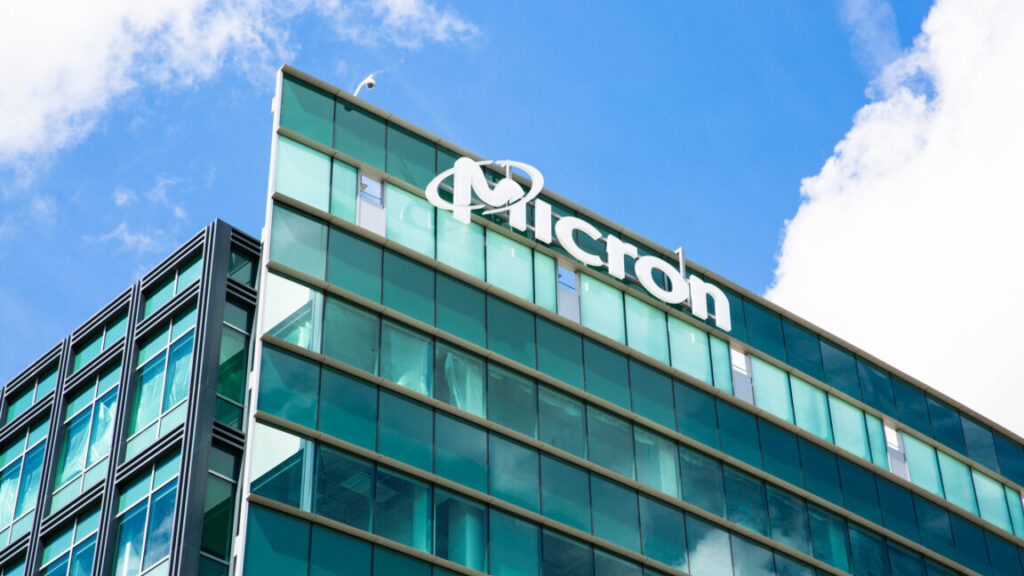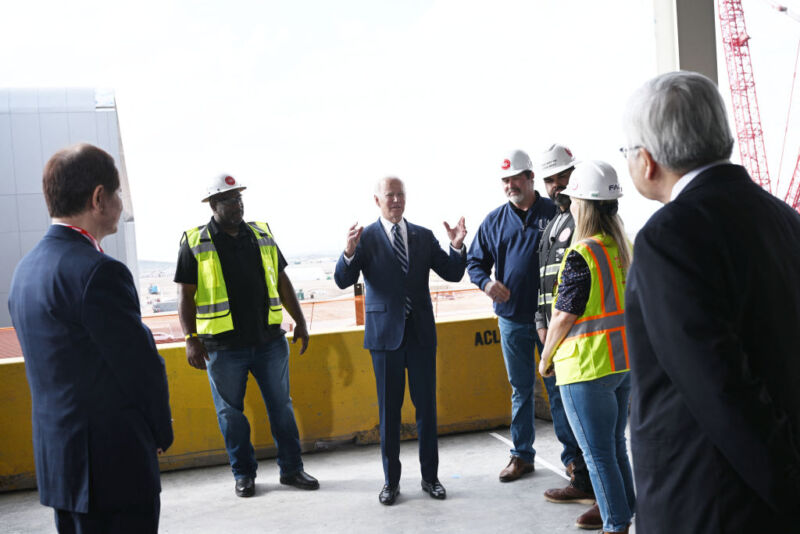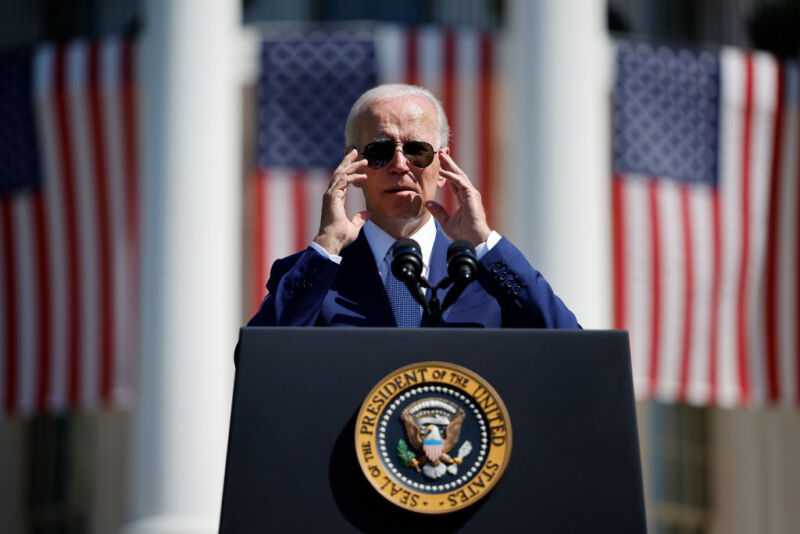Micron’s $6B CHIPS funding should have more strings attached, critics say
Micron’s NY fabs are the only CHIPS projects undergoing full environmental review.
Micron Technology will receive more than $6.1 billion after the US Department of Commerce finalized one of the largest CHIPS Act awards ever to “the only US-based manufacturer of memory chips,” Vice President Kamala Harris said in a press statement.
Micron will use the funding to construct “several state-of-the-art memory chips facilities” in New York and Idaho, Harris said. The chipmaker has committed to a “$125 billion investment over the next few decades” and promised to create “at least 20,000 jobs,” Harris confirmed.
Additionally, Micron “agreed to preliminary terms for an additional investment of $275 million to expand” its facility in Manassas, Virginia, Harris confirmed. Those facilities will mostly be used to manufacture chips for automotive and defense industries, Harris noted.
Because of billions in CHIPS funding doled out by the Biden administration, Harris said, the US’s “share of advanced memory manufacturing” will go “from nearly 0 percent today to 10 percent over the next decade.”
The Semiconductor Industry Association, a trade and lobbying group that bills itself as “the voice of the semiconductor industry,” celebrated Micron’s award. In a press release, its president and CEO, John Neuffer, said that the award sets the US on a path to become a leading memory chip innovator.
“Memory is a technology critical to America’s economic future and national security, and Micron’s historic investments in producing memory chips in the US will strengthen US leadership for the long term,” Neuffer said.
In a statement, Micron President and CEO Sanjay Mehrotra said that “Micron is uniquely positioned to bring leading-edge memory manufacturing to the U.S., strengthening the country’s technology leadership and fostering advanced innovation.”
“Micron’s investments in domestic semiconductor manufacturing capabilities, supported by the bipartisan CHIPS Act, will help drive economic growth and ensure that the US remains at the forefront of technological advancements,” Mehrotra said.
Advocates: Micron needs to explain what a “good job” is
But while Neuffer joined Harris’ and the Commerce Department’s chorus, praising the award for creating “high-paying American jobs,” bolstering US national and economic security, and fueling “innovation for years to come,” communities are raising questions.
Advocates with Jobs to Move America (JMA)—who are organizing ahead of Micron’s New York construction starting in 2026—are concerned that Micron hasn’t been clear about what a “good job” is before moving into an area with “one of the highest poverty rates in the country.”
“There has been little discussion or firm commitments made regarding what exactly a ‘good job’ is, or how equitable access for said jobs will be achieved for current local residents,” JMA’s “Good Jobs Platform,” drafted earlier this year with more than 20 local advocacy groups, said.
“We define a ‘good job’ as one that guarantees: workers have a fair and clear process to organize a union without employer opposition, family-sustaining wages and comprehensive benefits, safe working conditions, equitable hiring and employment practices, and is supported by an accessible workforce pipeline,” the platform said.
And equally important are communities’ and workers’ health and safety concerns, the platform noted, urging that “a good job is a safe job.”
A senior researcher and policy coordinator for JMA, Anna Smith, told Ars that Harris’ statement was missing any mention of a community impact statement. And while Harris mentioned “utilizing project labor agreements and registered apprenticeship programs, which will further strengthen local economies” and “support workers,” more enforceable commitments are needed to protect communities as Micron’s construction begins, Smith said.
The “Good Jobs Platform” recommends a range of commitments, from labor peace agreements that would ensure workers can unionize to community workforce agreements keeping workers involved in key discussions regarding ongoing training and career development. Local labor leaders have sought similar commitments, urging Micron to commit to a community benefits agreement “that enshrines legally enforceable provisions that protect the community, its workers, and the environment.”
In his statement, Mehrotra said that Micron had formed local partnerships to build a “community investment framework” that would “revitalize central New York.”
Micron first CHIPS fabs to get full environmental review
More transparency is also urgently needed regarding Micron’s environmental commitments, advocates told Ars. In New York, Micron’s fabs are preparing to wipe out over 200 acres of mature forested wetlands, and so far, Micron has not provided a public “detailed mitigation plan to compensate for the loss,” a local environmental expert, Catherine Landis, warned during a public comment period on Micron’s plan to pave over the wetlands.
Unlike any other fab site in the US receiving CHIPS Act funding, Micron’s New York fabs must release a full environmental impact statement (EIS), which is currently being drafted and expected to be distributed to agencies this month, advocates told Ars. Construction has been delayed until the EIS is completed, at which point the public will gain a better understanding of how much harm could be caused by the project and what steps Micron will take to mitigate harms.
JMA has warned about potential impacts, like increased flooding in the area impacting both communities and Micron’s fabs. Destroying the wetlands will also displace federally protected endangered animal populations, JMA said, including the northern long-eared bat and the sedge wren. Potential chemical spills, reported at other US fabs, could endanger water quality, as could any mismanaged handling of chemical waste. And perhaps most critically, the energy demand to operate Micron’s facilities could risk setting back New York’s climate goals, JMA advocates said.
More transparency would help communities better prepare to welcome Micron and other chipmakers developing fabs across the US. JMA and local experts have agreed that the promised economic benefits Micron’s fabs will deliver in New York are a positive development, as are Micron’s commitments guaranteeing New York construction workers can unionize.
But communities will likely be the ones raising alarms as Micron’s operations introduce to the environment “thousands of compounds used in chip manufacture (most unregulated)” with “short- and long-term effects on plants, animals, people” still largely unknown, Landis said. And that’s where JMA hopes to make an impact, submitting freedom of information acts to request undisclosed data and pushing for community benefit agreements and other commitments from Micron to ensure communities aren’t irreversibly harmed by new fabs.
JMA expects that the EIS could help galvanize communities preparing for Micron’s construction to start in New York.
“I do think it is a really helpful tool that we have in our belt, and something that will help the public engage about concerns that we have,” Smith told Ars. “It spans, of course, air emissions, wastewater, runoff, toxics, wetlands, but it also includes things like housing and transportation, and those are things that we think that the Syracuse community is very concerned about.”
The EIS could mean that New York residents have a clearer understanding of how CHIPS funding may be polluting their communities. Most of the other communities nationwide impacted by CHIPS projects likely won’t have the same level of detailed information. Eric Romann, a JMA regional director, told Ars that, while “it’s positive that a higher bar has been set” for Micron’s New York project, that’s only “compared to the very low bar set for the other projects around the country, or you could say very low to non-existent bar.”
Micron declined to comment directly on workers’ concerns. In a statement provided to Ars, Micron’s spokesperson said that “Micron is committed to environmental stewardship across our global operations, including developing and maintaining critical environmental protections for our planned investment” in New York.
“A required environmental impact statement is currently in production with both federal and state lead agencies, and we are working closely with government stakeholders to ensure we meet any environmental permitting required for the project,” Micron’s spokesperson said. “We look forward to engaging with the public and government stakeholders during comment periods for the project’s draft environmental impact statement and environmental permitting in the near future.”
Micron’s $6B CHIPS funding should have more strings attached, critics say Read More »




